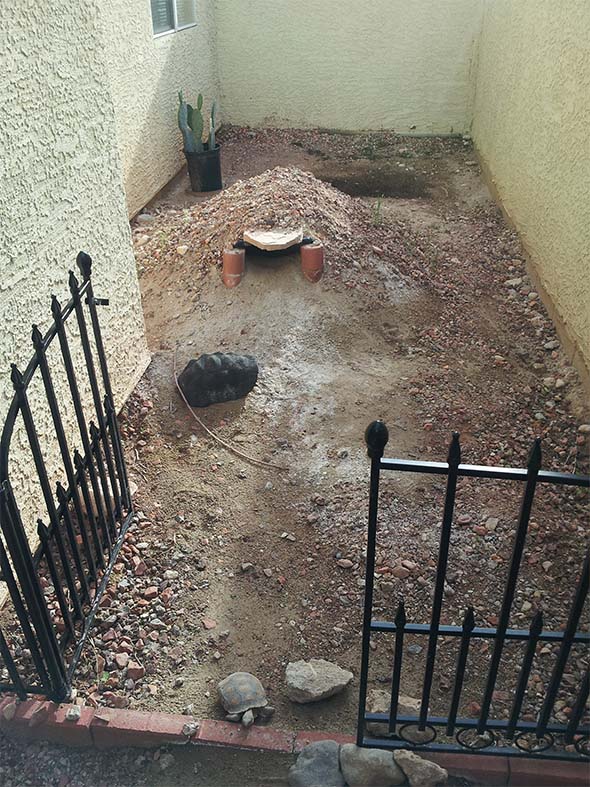
After six months of hibernation, Koopa was more than a little bit groggy.
This has been a roller coaster of an emotional year for me. My girlfriend and her child moved in during the summer, and it's been great having a family of my own. But sadly, shortly after my new family came together, we lost a member of that family.My beloved little baby tortoise Koopa died in a tragic accident back in August. It's taken me a while to work up the courage to write about it, and it still haunts and saddens me to this day.

Koopa came out of hibernation in spring and seemed to be happy and healthy.
A summer at the vet
The year started out well for myself and Koopa. She came out of hibernation a little early and seemed happy and healthy. She had a full appetite and was very active after her 6-month slumber, which is always a good sign. However, in April I started noticing an odd black residue lining her mouth. I feared that this might be a symptom of something like mouth rot, and so after waiting a couple days to see if it cleared up on its own, I took her to a local veterinarian.
The vet suspected that the problem was likely a bacterial respiratory infection, which is a common condition for tortoises. If left untreated, it can develop into more serious illnesses such as pneumonia, which can be fatal. But it's fairly easy to treat if caught early, so the vet started Koopa on a regimen of antibiotics. She also took a blood sample and cultures from the mouth to try to identify the specific contagion.
We started with a series of antibiotic shots administered every three days for a few weeks. Koopa did not like those at all! I would place her in an old Amazon cardboard box in order to take her to the vet, and it was clear that she did not like being placed in those boxes. The shots also seemed to hurt or cause slight discomfort, as I would sometimes see her stretch or roll her leg after getting the shot. It was a motion similar to how a person might rotate your arm around to stretch out a sore shoulder. But since it was her front leg, it often resulted in her faceplanting into the ground. It was a little cute and funny, and I wish I had video of it.

You may see a similar residue after a tortoise eats (from the wetness of the food),
but if it persists and darkens, then it is indicative of a respiratory infection.
The vet also recommended that I keep Koopa indoors until the variable spring weather passed and the consistent heat of summer showed up. She wanted a stable temperature and environment for Koopa in order to help manage the infection. I didn't have a terrarium or anything, so I had to keep Koopa in a large cardboard box with a heat lamp mounted over it. Koopa didn't like the box very much, so I'd let her out in the back yard whenever it was warm enough.
The black residue eventually started clearing up, and Koopa seemed to be doing very well. She kept a healthy appetite all throughout the treatment. In fact, she ate way more than I had ever seen her eat. She grew considerably over the course of the summer, increasing her weight by a whole third.
But the culture returned positive for a particularly nasty reptillian infection called mycoplasma. This forced us to also have to give her a regimen of a liquid antibiotic over the course of several months. I'd have to mix the antibiotic into her food every few days. This was easy enough, as I'd usually just use the syringe to spread the medicine over a dandelion flower. Dandelions were her favorite food, and she would gobble the medicated flowers up in no time, leaving virtually no trace!
Again, she did not show any worrisome symptoms, and it seemed that we had the illness well under control. It was a huge relief, as I was very worried when she first became sick. The vets did an excellent job of taking care of her, and it seemed that she was going to make a full recovery. We expected that the worst case scenario was that she would remain a carrier for the disease, and could relapse or spread it to other tortoises. But it would be easy enough to control, and she didn't live with any other tortoises, so there was no risk of infection.

We had to keep Koopa inside during the spring in order to maintain a stable temperature and environment.
Preparing for indoor hibernation
Just to be safe, I resolved to hibernate Koopa indoors this winter. I wanted to keep her out of the elements so that I wouldn't have to worry about a severely cold or wet winter possibly aggravating her condition and resulting in a relapse during hibernation.
I had planned on buying a medium-size terrarium and lining it with a faux-dirt mat and maybe some real dirt from the backyard. I would place her little tortoise-shell shelter in the terrarium so that she would have a dark, secluded place to sleep, and I would cover the terrarium with a blanket or towels to help insulate it.
I would rest easy knowing that she was not exposed to the elements, and that I could easily check on her condition whenever I would want to.
But I won't get to put that plan into practice...
[More]